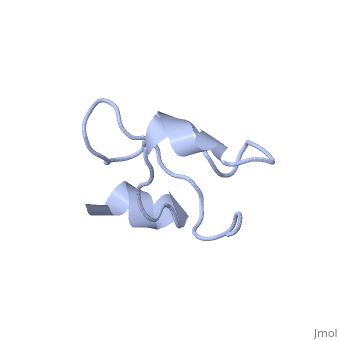1z99
From Proteopedia
Solution structure of Crotamine, a myotoxin from Crotalus durissus terrificus
Structural highlights
FunctionMYC2_CRODU Cationic peptide that possesses multiple functions. It acts as a cell-penetrating peptide (CPP), and as a potent voltage-gated potassium channel inhibitor. It exhibits antimicrobial activities, hind limb paralysis, and severe muscle necrosis by a non-enzymatic mechanism. As a cell-penetrating peptide, crotamine has high specificity for actively proliferating cells, and interacts inside the cell with subcellular and subnuclear structures, like vesicular compartments, chromosomes and centrioles. It penetrates into the cells as fast as five minutes after its addition to cell culture medium (PubMed:18662711). In vivo, after intraperitoneal administration, it is found in cells of peritoneal fluid and bone marrow, demonstrating preferential nuclear and perinuclear localization. To enter the cell, it interacts with the chains of heparan sulfate membrane proteoglycan (HSPG), and is endocytosed (in complex with HSPG) in vesicles which are transported into the cell with the help of clathrin. Inside the cell, crotamine accumulates in lysosomal vesicles. As soon as the peptide accumulates in endosomes/lysosomes vesicles, these compartments are disrupted and their contents released into the cytosol. This loss of lysosomal content induces cell death at high concentrations, or promotes the distribution of crotamine in cytoplasmic compartments, which is a step before crotamine nuclear uptake (PubMed:15231729, PubMed:17491023). As a potassium channel inhibitor, this toxin selectively inhibits Kv1.1/KCNA1, Kv1.2/KCNA2 and Kv1.3/KCNA3 channels with an IC(50) of 369, 386 and 287 nM, respectively (PubMed:22498659). The inhibition of Kv1.3/KCNA channels induced by this toxin occurs rapidly and is voltage-independent. The channel inhibition is reversible after washing, suggesting a pure and classical channel blockage effect, without effects in potassium channel kinetics (PubMed:22498659). As an antimicrobial peptide, crotamine shows antibacterial activity against E.coli and B.subtilis, and antifungal activity against Candida spp., Trichosporon spp. and C.neoformans. It kills bacteria through membrane permeabilization.[1] [2] [3] [4] [5] [6] [7] [8] [9] [10] [11] [12] Evolutionary ConservationCheck, as determined by ConSurfDB. You may read the explanation of the method and the full data available from ConSurf. Publication Abstract from PubMedCrotamine is one of four major components of the venom of the South American rattlesnake Crotalus durissus terrificus. Similar to its counterparts in the family of the myotoxins, it induces myonecrosis of skeletal muscle cells. This paper describes a new NMR structure determination of crotamine in aqueous solution at pH 5.8 and 20 degrees C, using standard homonuclear 1H NMR spectroscopy at 900MHz and the automated structure calculation software ATNOS/CANDID/DYANA. The automatic NOESY spectral analysis included the identification of a most likely combination of the six cysteines into three disulfide bonds, i.e. Cys4-Cys36, Cys11-Cys30 and Cys18-Cys37; thereby a generally applicable new computational protocol is introduced to determine unknown disulfide bond connectivities in globular proteins. A previous NMR structure determination was thus confirmed and the structure refined. Crotamine contains an alpha-helix with residues 1-7 and a two-stranded anti-parallel beta-sheet with residues 9-13 and 34-38 as the only regular secondary structures. These are connected with each other and the remainder of the polypeptide chain by the three disulfide bonds, which also form part of a central hydrophobic core. A single conformation was observed, with Pro13 and Pro21 in the trans and Pro20 in the cis-form. The global fold and the cysteine-pairing pattern of crotamine are similar to the beta-defensin fold, although the two proteins have low sequence homology, and display different biological activities. Automated NMR structure determination and disulfide bond identification of the myotoxin crotamine from Crotalus durissus terrificus.,Fadel V, Bettendorff P, Herrmann T, de Azevedo WF Jr, Oliveira EB, Yamane T, Wuthrich K Toxicon. 2005 Dec 1;46(7):759-67. Epub 2005 Sep 26. PMID:16185738[13] From MEDLINE®/PubMed®, a database of the U.S. National Library of Medicine. See AlsoReferences
| ||||||||||||||||||


